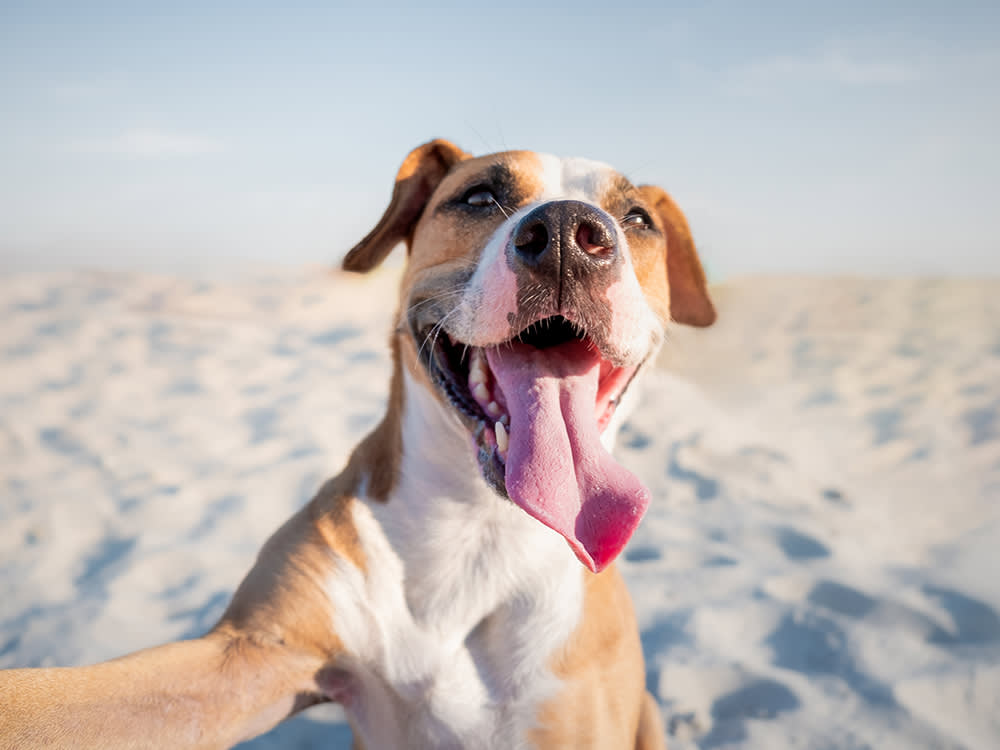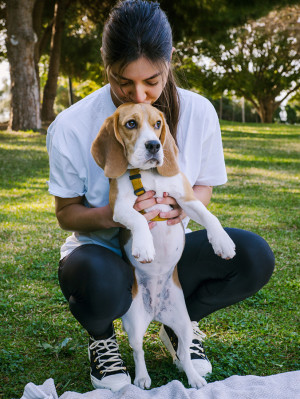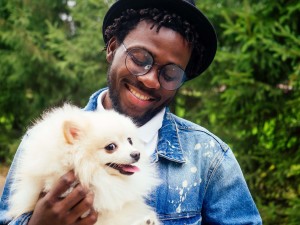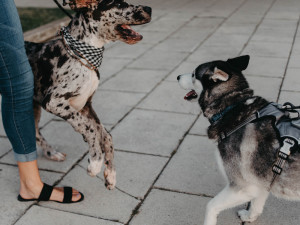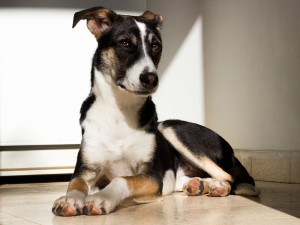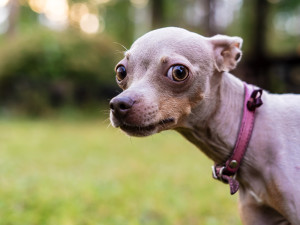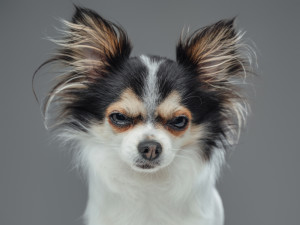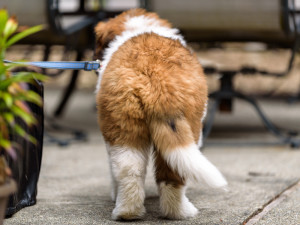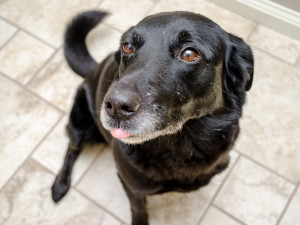Can Dogs Smile?
There’s a big difference between a dog smiling and showing their teeth.
A dog smile is a very specific behavior, but not nearly as common or as identifiable as the grin. It’s challenging to recognize and understand a dog smile, which is unfortunate, but on the bright side, that struggle was at the heart of one of my all-time favorite consultations. More on that below.
Do dogs smile?
Yes, dogs smile, but they also grin, and it’s not the same thing. Further complicating the basic situation of dogs letting us see their pearly whites, they can also show their teeth in other expressions that mean entirely different things.
The reason I loved the consultation was that a family worried they had a serious behavior problem in their household but luckily, did not have a problem at all. The confusion came about because they misunderstood one of their dog’s facial expressions. This young couple was worried about how their beloved Golden Retriever was “showing his teeth” to their new baby. They feared that this behavior — which happened whenever they brought their daughter into the living room after a nap, when he first saw her each morning, and when they came home with her after an absence — was aggressive.
Because the teeth-showing was always in greeting and because their dog seemed about as threatening as a butterfly, I suspected the dog was smiling, but I needed to know for sure because a baby’s safety depended on my assessment of the situation. I had the family step into the hallway with the baby for a few minutes, then return to my office.
How much do you spend on your pet per year?
That’s when I saw it: a friendly smile by a friendly dog. It was accompanied by a loose body, a gentle but enthusiastic tail wag, a relaxed face, and what I can only describe as an adoring gaze. And, just as when humans do it, his smile involved showing some teeth.
What’s a dog smile, and why do they do it?
A true dog smile involves a retraction of the lips that reveals the top and (usually the bottom) teeth as well. Because it resembles an aggressive expression called a “tooth display” that I discuss below, it can freak people out. However, this kind of smile has absolutely nothing to do with aggression. In fact, it’s a friendly expression.
Whenever a dog smiles in this fleeting, friendly, social way, I’m delighted. In my opinion, it reveals many positive qualities about that dog, and about the relationship between the dog and the recipient of the smile. Smiling dogs tend to be social, affiliative, and loving. That said, I’m not aware of any scientific studies that explore the meaning and context of such smiles.
So, I base this opinion on my own experience with smiling dogs, as well as discussions with other dog trainers and behaviorists over the years. Smiles are often given when greeting people the dog adores, especially if the dog hasn’t seen the person for some time. The smiles seem to indicate that the dog is over the moon about the reunion, and about the opportunity to greet the person.
I recently discussed what we animal behaviorists call “smiles” with Chelse Wagner, a certified behavior consultant and dog trainer at Dog’s Best Friend Trainingopens in new tab in Madison, Wisconsin. Wagner pointed out that while dogs displaying a smile tend to have loose bodies, they will often hold their ears back and keep their body lower to the ground; this can make them seem ambivalent or conflicted, rather than happy.
Smiles happen quickly and are subtle. The upward movement of the lips away from the teeth is often slight, and the retraction rarely lasts more than a second. The combination of minimal movement and speed makes it a challenge to capture them photographically. You must be at exactly the right angle and height, which is difficult when a dog is moving around, often wagging not just the tail, but much of the body, as is so often the case when dogs smile.
What’s a dog grin, and why do they do it?
What many people call a dog smile is really a grin — a happy, open-mouthed face of a jolly dog. This common facial expression is what many people are referring to when they say a dog is smiling, and that is just because the dog is happy and has its lips in a shape that looks like human smiles. In this “happy grin” kind of smile, which can last for minutes, the lower jaw hangs open and the corners of the lips are pulled back in a relaxed way.
Sometimes, the tongue hangs out, or is at least visible inside the mouth. Though the bottom teeth often show, the top teeth aren’t likely to. Dogs generally show this facial expression when they are relaxed and comfortable in a situation — so generally, seeing this expression is a good indication that your dog is happy.
Panting dogs resemble grinning dogs, so if your dog has their mouth wide open and their tongue hanging out, heat could be the cause rather than happiness. It’s not always easy to tell if your dog is grinning or panting, but paying attention to the context is the best way. If your dog appears to be grinning but they just ran or played hard or it’s hot out, they may simply be panting. Your dog can be panting and feel happy or feel not so happy, but the open-mouth facial expression is not enough to let you know for sure.
What’s a fear grimace and why do they do it?
When the corners of a dog’s mouth, or commissures, are pulled back tautly, it is a sign that the dog is fearful, and this facial expression is called a fear grimace. In a fear grimace, many of the dog’s teeth are visible, but the expression is not a smile, and it’s not a grin. The mouth is very tight, and the corners are pulled back, rather than up.
Typically, a dog with a fear grimace has a tense body, and nothing about them gives a sense of relaxation, joy, or playfulness. The classic sign on fences showing the head of a salivating dog with all their teeth in full glory that says “Beware of Dog” is not a calm, confident watchdog, but rather a terrified dog with a fear grimace.
What’s a tooth display, and why do they do it?
A tooth display is an offensive threat display, and the name is accurately descriptive. It’s a visual signal in which a dog retracts their lips and shows their teeth. In a full tooth display, they show both upper front and lower front teeth, but sometimes only the upper teeth are visible. When people say, “My dog curled his lip at me,” they are often describing a tooth display in which they lift their lip a little.
In contrast to the loose, wiggly bodies that typical go with smiles and grins, tooth displays are usually performed by a dog who’s fairly stiff and still in both body and face. The showing of the teeth proceeds more slowly, and the expression can last for several seconds or more. Tooth displays are often an indication that a dog has been pushed past their comfort zone, perhaps by the approach or touch of another dog or a person, when they have a treasured object, or when they’re exhausted or perhaps in pain and want to be left alone.
Sometimes, a tooth display is accompanied by a wrinkled nose. When dogs are tooth-displaying and the nose wrinkles, I think it indicates a higher level of emotional arousal and a lower level of emotional control, which makes the dog less predictable.
What’s a canine play face, and why do they do it?
Dogs have an expression often seen when dogs are playing with each other called a play face. A play face involves a relaxed open mouth and sometimes you can see a dog’s teeth. More commonly, those teeth are visible during some kinds of play called bitey face and jaw sparring. Dogs often play with their mouths open, their lips retracted, and teeth fully visible.
Although it’s a form of play and dogs tend to keep their mouths open wide rather than biting down on each other, photographs of the behavior can look quite alarming. When the action is frozen, you can see the dogs’ full sets of teeth, and the lips pulled back enough to see the full form of many of those teeth. When teeth are not being used on one another, and everyone is having a good time, you are most likely watching dogs happily playing.
Teeth show in a lot of canine expressions.
Dogs show their teeth in a variety of expressions, and they are not all smiles. To make understanding dogs even more confusing, the expression that is most like a human smile isn’t called a smile — it’s called a grin. At least both grins and smiles are generally signs that we like to see in our dogs. Play faces are less well-known than other facial expressions involving teeth, but still heart-warming to observe.
In contrast, tooth displays and fear grimaces are not quite so welcome, though the information that our dogs might not be feeling positive emotions is useful and definitely good to know, even if we wish they felt otherwise. There’s a lot to know about all these expressions, including that showing dog teeth does not a smile make.
FAQs (People also ask):
Is my dog panting or smiling?
Remember, panting dogs look more like they’re grinning, which is much wider than a smile. If you see your dog grinning – and they’ve just taken part in exercise or play – they could be panting, especially if it‘s hot outside.
